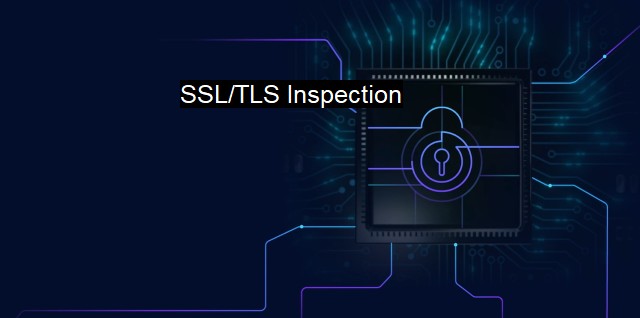What is SSL/TLS Inspection?
Securely Unpacking Encrypted Traffic: Understanding SSL/TLS Inspection and Its Importance in Cybersecurity
Secure Sockets Layer/Transport Layer Security (SSL/TLS) Inspection is a significant concept in the field of cybersecurity. It is a security process that intercepts and decrypts data from SSL/TLS encrypted traffic to scan for potential threats such as malware, viruses, and other intrusions. As SSL/TLS encryption has become the standard for safeguarding web traffic, cybercriminals have started to use this encryption method to hide their nefarious actions, making SSL/TLS Inspection a critical measure in today's security strategies.SSL and TLS are cryptographic protocols designed to provide communication security over the Internet. They employ a system of public and private keys to encrypt data transferred over the net, essentially creating a private conversation that only the involved parties can understand. cybercriminals may exploit these safeguarding measures to hide malware in encrypted packets, making it extremely challenging for traditional security measures to identify and neutralize threats as they are unable to analyze encrypted data.
SSL/TLS Inspection, a feature included in many advanced antivirus software solutions and firewalls, addresses this problem effectively. By positioning itself between the client-computer (endpoint) and the server, SSL/TLS Inspection creates a 'man-in-the-middle' condition wherein it can decrypt, analyze, and re-encrypt data passing through. This way, the security tool can thoroughly inspect all incoming and outgoing traffic, discovering threats nestled within encrypted packets that would otherwise bypass unnoticed.
SSL/TLS inspection applies trusted certificates on the security tool so when an endpoint initiates a secured connection, the tool creates two SSL connections. One connects with the endpoint, and the other to the server. Both the server and the client think they're communicating directly with each other, while in reality, the SSL/TLS Inspection technique allows the security tool to peer inside the SSL traffic, decrypt and scan the contents, ensuring that no hidden threats infiltrate the network.
Therefore, the fundamental advantage of SSL/TLS inspection is that it provides comprehensive visibility into encrypted traffic, allowing security tools to detect potential threats that might otherwise evade detection. This helps protect networks from viruses, malware, and other types of cyber threats concealed within encrypted traffic.
Along with these significant security improvements, SSL/TLS Inspection also comes with certain challenges. These primarily involve privacy and performance concerns. Decrypting and inspecting sensitive data can compromise individual privacy if appropriate policies and measures to handle this data aren't in place. Organisations need to be prudent and selective about where and when they apply SSL/TLS inspection.
Performance can also become an issue, since decrypting, inspecting, and re-encrypting data demands substantial processing power. This can slow down network speed. To mitigate these concerns, solutions such as deploying powerful hardware or scaling inspection with the rise in traffic are imperative.
In synopsis, SSL/TLS Inspection is a fundamental cybersecurity element, significantly piecing together security configurations to effectively protect networks in the era of rising encrypted cyber threats. An organisation needs to assess the privacy concerns and performance ramifications and then tactically utilize SSL/TLS inspection within their IT infrastructure for optimal protection against cybersecurity threats. Despite these challenges, failing to perform SSL/TLS inspection can expose organizations to risks far more severe than slowed network speeds, striking a serious blow to their data integrity, privacy, and overall cybersecurity posture.

SSL/TLS Inspection FAQs
What is SSL/TLS inspection in cybersecurity?
SSL/TLS inspection is a process where security devices such as antivirus, IDS, and firewalls intercept and decrypt SSL/TLS traffic to inspect it for any malicious activity.Why is SSL/TLS inspection necessary in cybersecurity?
SSL/TLS encryption is designed to protect data in transit, but it can also be used by cybercriminals to hide malicious activities. SSL/TLS inspection ensures that encrypted traffic is scrutinized for any malicious activity before it enters the network.Does SSL/TLS inspection weaken encryption?
No, SSL/TLS inspection does not weaken encryption. Antivirus and other security devices use their own certificates to decrypt SSL/TLS traffic temporarily while inspecting it for malicious activity. This process does not affect the encryption of the original SSL/TLS connection.What are the challenges of implementing SSL/TLS inspection?
Implementing SSL/TLS inspection can be challenging. It requires deploying security devices that can decrypt and re-encrypt SSL/TLS traffic, which can slow down network performance. There is also the issue of maintaining security and compliance with privacy regulations when inspecting encrypted traffic.| | A | | | B | | | C | | | D | | | E | | | F | | | G | | | H | | | I | | | J | | | K | | | L | | | M | |
| | N | | | O | | | P | | | Q | | | R | | | S | | | T | | | U | | | V | | | W | | | X | | | Y | | | Z | |
| | 1 | | | 2 | | | 3 | | | 4 | | | 7 | | | 8 | | |||||||